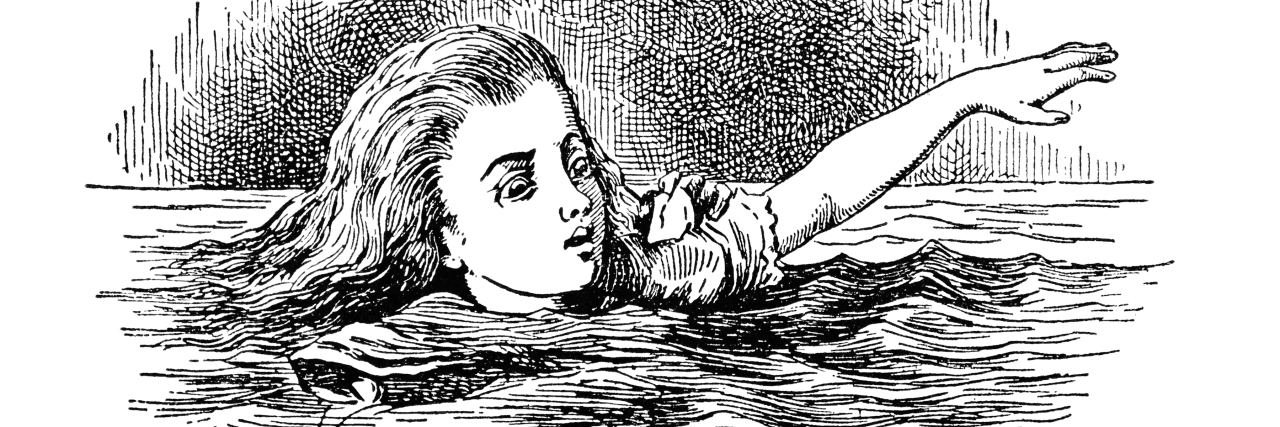“Can you stand on your head?”- Cheshire Cat
One of the most famous stories and movies is “Alice in Wonderland.” It is one of my favorites. It was written by Lewis Carroll in 1865. The original book was called “Alice’s Adventure in Wonderland,” but later shortened to “Alice in Wonderland.” If you haven’t read or seen any variation of the movie, it is a story about a little girl named, Alice, who falls through a rabbit hole into a fantasy world while experiencing many peculiar adventures with creatures and experiences.
One known fact about Lewis Carroll is that he was known to get chronic migraines and he also had epilepsy. He experienced migraine aura symptoms before he wrote “Alice in Wonderland.” The theory is that some parts of Alice’s adventures were based on Lewis Carroll’s own migraine aura perception. This theory does explain the similarities between a migraine aura and an active migraine (This theory is supported by many universities around the world).
So, why do I connect with Lewis Carroll besides being my favorite author? Because I experience severe chronic migraines and seizures too. I have been collecting “Alice in Wonderland” copies for years, it’s my favorite Disney movie classic, and I have an Alice in Wonderland tattoo. But this was all before I found out that he was a migraineur. Once I knew that some of Alice’s adventures were loosely based on his struggle with the symptoms, I saw the movie completely differently. It hit differently. I totally got the movie and book, and saw my symptoms and pain come to life. Sometimes it is difficult for me to explain how I feel or how intense the pain is. Or how horrible it is to live like this. I just tell people, “Have you seen ‘Alice in Wonderland?’ THAT is how I feel.”
Did you know there is a real neurological disorder called the Alice in Wonderland Syndrome(AIWS)? According to WebMD, It’s a rare neurological disorder characterized by distortions of visual perception, body image, and the experience of time. People may see things smaller than they are, feel their body alter in size, or experience any of the syndrome’s numerous other symptoms.
These brief episodes of visual hallucinations and distorted perception appear during the aura stage before a migraine attack. Each episode can last seconds to minutes. Symptoms of AIWS include a number of changes, along with a feeling of individualization, that affect things like:
Sense of time: the clock may appear to speed up or time may seem to pass very slowly
Hearing: sounds are exaggerated
Sight: objects appear to change in size, distance, or position
Feeling: as if levitating free from gravity
Visual disturbances of a migraine:
Photopsia: bright flashes of light in the visual field
Teichopsia: bright, shimmering, lines in the visual field
Scotoma: partial loss of vision, ranging from blank spots to tunnel vision
Metamorphopsia: the medical term for Alice in Wonderland Syndrome, describing the distortion of visual images in their size, shape, and color
The visual disturbance characteristic to AIWS usually appear before a migraine attack by 20 to 60 minutes. While Alice in Wonderland Syndrome is more dramatic, it is not the most common migraine warning symptom. Blurred vision and sensitivity to light are the visual disturbances seen most within migraineurs.
AIWS episodes may go on several times during the day. Understandably the surreal sensory-perceptive episode often cause anxiety in those who get migraines. It’s like not feeling in control of normal senses, such as like the White Rabbit, are decidedly not behaving normally. You can talk to your doctor about the AIWS if you suspect you get these symptoms or are concerned.
Having someone who not only endured what you go through, but visually put it into words, then it got put on the big screen made me feel glad knowing that it’s out there. Migraines don’t have a cure and don’t get the attention they NEED. Migraines are affecting so many of us daily and we get little to no relief. And I am pretty sure, not many know this information about Alice in Wonderland either. It is very comforting to see my symptoms and pain in color and out there for the world to see when I can’t even utter the words to express it.
“I’m afraid I can’t explain myself, sir. Because I am not myself, you see?”– Alice
Photo credit: Bloodlinewolf/Getty Images

